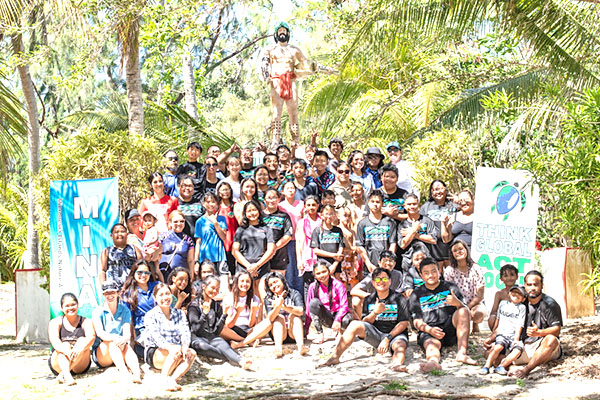MINA brings conservation program to Managaha
Group photo of Schools for Environmental Conservation students, teacher, Micronesia Islands Nature Alliance Tasi Watch Rangers, presenters, and volunteers have their picture taken by the Chief Aghurubw statue on Managaha. (Contributed Photo)

The Micronesia Islands Nature Alliance held the second workshop for its annual “Schools for Environmental Conservation” program by hosting the participants on Managaha Island on March 9, 2019.
SFEC is funded through the Department of the Interior and is designed to engage students in educational and field activities while focusing on environmental issues.
Participating in this year’s program are students from Mount Carmel School, Dandan Middle School, Hopwood Middle School, and Tanapag Middle School.
This year’s SFEC theme is “Learning About and Actively Addressing Marine Debris in the CNMI.”
The objective is to raise awareness of the flood of debris that washes up on the shores of the CNMI from other countries and gets left behind by beachgoers, visitors, and residents, and the harm it does to marine life.
SFEC students and their teachers spent the day on Managaha to gain more insight on the dangers and effects of marine debris, and how measures are being taken in the CNMI for the conservation of natural resources.
The workshop featured the topics of marine protected areas by Kevin Camacho (Division of Fish and Wildlife), enforcement by Marvin Pangelinan and Esteven Tenorio (DFW), fisheries by Gina Tomokane (DFW), sea turtle program by Carey Demapan (Department of Lands and Natural Resources), historic and cultural aspects by Lucas Simonds (Historic Preservation Offive), and human impact surveys by Kelsey McClellan (Division of Coastal and Reef Management).
Simonds showed the students wreckage from World War II that has remained on the beach by the dock at Managaha. “It’s only 75 years or so that it’s been here, but it’s already starting to get covered in coral and there are fish all over that. At this point, it has grown into a place of shelter for marine life and is part of our history, but is still categorized as marine debris.”
McClellan spoke of how human activities, as well as marine debris, have measurable impacts on our natural resources. She instructed the students on how to conduct human impact surveys on land and in the water, as they observe popular beach activities such as snorkeling, swimming, wading and picnicking. They also observed negative behaviors such as fish-feeding, removing live animals, breaking off coral, and littering. By measuring the intensity and frequency of these behaviors, DCRM can identify the impacts visitors have on prime tourist sites.
McClellan said, “By understanding these behaviors, we can work with tour operators and tourists alike to educate visitors about responsible and sustainable tourism.”
MINA would like to express their gratitude for the collaboration of the various agencies who helped to make this event successful. Sincere appreciation also goes out to the teachers of the participating schools, volunteers, and MyCapitures Photography.
To learn more about MINA’s Schools for Environmental Conservation program, visit MINA’s Facebook page, email MINA at minaoutreach@gmail.com or call us at 233-7333 (REEF). (MINA)






